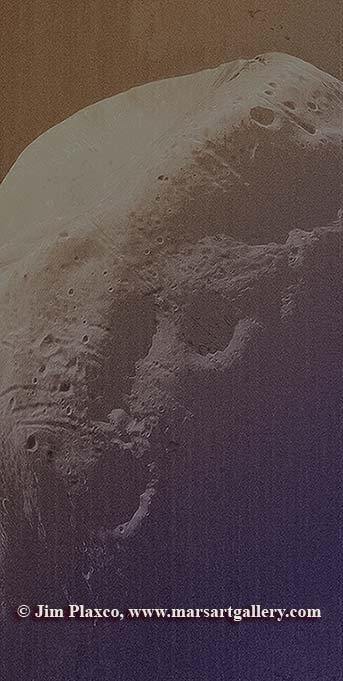Columbiad II's First Daguerreotype of Phobos

Image Title: Columbiad II's First Daguerreotype of Phobos
Source: Mars Global Surveyor
Description
I created the above image of Phobos in an attempt to produce a daguerreotype sort of picture that has had a 100 plus years to age. There were two sources of inspiration for the creation of this image.
Jules Verne, who died March 24, 1905, was certainly a science fiction visionary. In one of his books, From the Earth to the Moon written in 1865, Verne describes a journey to the Moon. In the story, a crew of three is literally blasted to the Moon aboard a capsule. Their launch vehicle is a giant 900 foot long cannon named Columbiad. Strangely, the capsule that is to carry the three adventurers to the Moon does not get a name and is only referred to as a 'projectile coach.'
At the time Verne wrote his classic story about a human mission to the Moon, photography was only some 40 years old. One popular photographic method was the daguerreotype. In 1852, John Whipple made a daguerreotype of the Moon using the fifteen-inch telescope of the Harvard College Observatory. This image of the Moon has a certain artistic quality to it.
What if, I wondered, there had been a manned mission to Mars inspired by the work of Jules Verne? Of course the crew would want to return home with some record of their historic visit to the red planet. What better record than photographic evidence of their observations.
I therefore resolved to create an image that had the feel of a less-than-perfect daguerreotype that has been sitting on a shelf for more than 100 years.
Background on the Martian Moon Phobos
Phobos was discovered in 1877 by American astronomer Asaph Hall. It is the larger of the two Martian moons and orbits closer to the surface than its smaller counterpart Deimos. In fact, compared to the Earth's moon, it orbits amazingly close to the surface. While our moon is in an orbit of 384,400 kilometers, as measured from the center of the Earth, Phobos' orbit is a mere 9,378 kilometers. With such a small orbit, Phobos is actually able to complete one orbit of Mars in only 7 hours and 39 minutes. Because it is orbiting Mars faster than the planet rotates, an observer on Mars would see Phobos rise in the west, move rapidly across the sky and set in the east. If our observer wanted a replay, all they would have to do is to wait a few hours for a repeat performance.
The nature of Phobos' orbit and its composition, like that of Deimos, leads us to believe that the pair of martian moons are actually captured C-type asteroids.
The large crater at the top of the picture of Phobos is that moon's most prominent feature. It's name is Stickney and is the maiden name of Asaph Hall's wife. The crater is approximately 10 kilometers in diameter.
Some Phobos Facts
| Radius (km) | Orbital Distance from Primary (km) | Mean Orbital Velocity (km/s) | Mass (Kg) | Density (gm/cm3) | Year Discovered |
| 13x11x9 | 9378 | 2.137 | 10800 | 2 | 1877 |
Source Image Background
This image was created from a Mars Global Surveyor Mars Orbiter Camera image. Information about the original source image is available at PIA01334: High-Resolution MOC Image of Phobos with Graphics Overlay on the NASA JPL Planetary Photojournal web site.
Image Processing
All processing of the image of Phobos was done using Adobe Photoshop. The colors were chosen to somewhat resemble the colors seen in some daguerreotypes.

